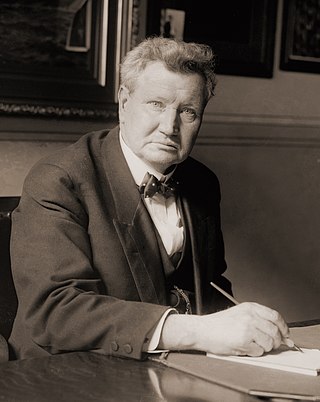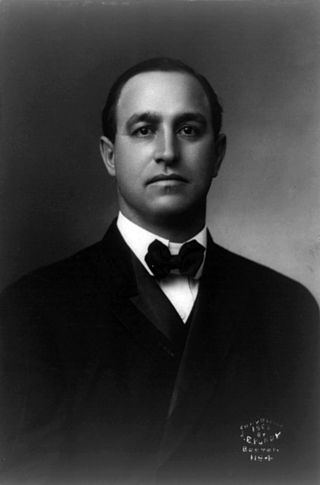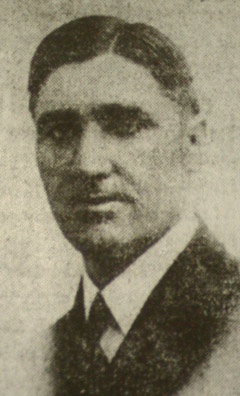Related Research Articles

John Llewellyn Lewis was an American leader of organized labor who served as president of the United Mine Workers of America (UMW) from 1920 to 1960. A major player in the history of coal mining, he was the driving force behind the founding of the Congress of Industrial Organizations (CIO), which established the United Steel Workers of America and helped organize millions of other industrial workers in the 1930s, during the Great Depression. After resigning as head of the CIO in 1941, thus keeping his promise of resignation if President Franklin Delano Roosevelt won the 1940 election against Wendell Willkie, Lewis took the United Mine Workers out of the CIO in 1942 and in 1944 took the union into the American Federation of Labor (AFL).

The United Mine Workers of America is a North American labor union best known for representing coal miners. Today, the Union also represents health care workers, truck drivers, manufacturing workers and public employees in the United States and Canada. Although its main focus has always been on workers and their rights, the UMW of today also advocates for better roads, schools, and universal health care. By 2014, coal mining had largely shifted to open pit mines in Wyoming, and there were only 60,000 active coal miners. The UMW was left with 35,000 members, of whom 20,000 were coal miners, chiefly in underground mines in Kentucky and West Virginia. However it was responsible for pensions and medical benefits for 40,000 retired miners, and for 50,000 spouses and dependents.

The Western Federation of Miners (WFM) was a labor union that gained a reputation for militancy in the mines of the western United States and British Columbia. Its efforts to organize both hard rock miners and smelter workers brought it into sharp conflicts – and often pitched battles – with both employers and governmental authorities. One of the most dramatic of these struggles occurred in the Cripple Creek district of Colorado in 1903–1904; the conflicts were thus dubbed the Colorado Labor Wars. The WFM also played a key role in the founding of the Industrial Workers of the World in 1905 but left that organization several years later.

The Communist Party USA and its allies played an important role in the United States labor movement, particularly in the 1930s and 1940s, but wasn't successful either in bringing the labor movement around to its agenda of fighting for socialism and full workers' control over industry, or in converting their influence in any particular union into membership gains for the Party. The CP has had only negligible influence in labor since its supporters' defeat in internal union political battles in the aftermath of World War II and the CIO's expulsion of the unions in which they held the most influence in 1950. After the expulsion of the Communists, organized labor in the United States began a steady decline.
Joseph Baruch (J.B.) Salsberg was a politician in Ontario, Canada. He was a Labor-Progressive member of the Legislative Assembly of Ontario from 1943 to 1955 who represented the riding of St. Andrew in downtown Toronto. He was a longtime Communist and activist in the Jewish community.

William Bauchop Wilson was an American labor leader and progressive politician, who immigrated as a child with his family from Lanarkshire, Scotland. After having worked as a child and adult in the coal mines of Pennsylvania, he became active as a labor organizer.

Philip Murray was a Scottish-born steelworker and an American labor leader. He was the first president of the Steel Workers Organizing Committee (SWOC), the first president of the United Steelworkers of America (USWA), and the longest-serving president of the Congress of Industrial Organizations (CIO).

John Philip Frey was a labor activist and president of the American Federation of Labor's Metal Trades Department during a crucial period in American labor history.

Edward Boyce was president of the Western Federation of Miners, a radical American labor organizer, socialist and hard rock mine owner.
Arnold Ray Miller was a miner and labor activist who served as president of the United Mine Workers of America (UMWA), AFL–CIO, from 1972 to 1979. Winning as a reform candidate, he gained positive changes for the miners, including compensation for black lung disease. He had difficulty dealing with growing internal union opposition. His last two years as president were particularly tumultuous and he suffered two heart attacks, finally resigning in November 1979 with the title of "president emeritus for life".

Thomas Kennedy was a miner and president of the United Mine Workers of America (UMWA) from 1960 to 1963.

Cleveland Lowellyn "Cleve" Robinson was a Jamaican-born American labor organizer and civil rights activist. He was a key figure in the 1963 March on Washington for Jobs and Freedom, for which he acted as the Chairman of the Administrative Committee.

John Mitchell was a United States labor leader and president of the United Mine Workers of America from 1898 to 1908.

Adoph F. Germer was an American socialist political functionary and union organizer. He is best remembered as National Executive Secretary of the Socialist Party of America from 1916 to 1919. It was during this period that the Left Wing Section of the Socialist Party emerged as an organized faction. Germer was instrumental as one of the leaders of the SPA's "Regular" faction in orchestrating a series of suspensions, expulsions, and "reorganizations" of various Left Wing states, branches, and locals and thereby controlling the pivotal 1919 Emergency National Convention of the SPA, and thus forcing the Left Wing to establish new organizations of their own, the Communist Labor Party of America and the Communist Party of America.

William Francis Dunne was an American Marxist political activist, newspaper editor and trade unionist. He is best remembered as the editor of the radical Butte Bulletin around the turn of the 1920s. As an editor of the daily newspaper of the Communist Party USA from the middle-1920s through the 1930s. Dunne was founding member of the Communist Labor Party of America, but was removed from the national leadership of the party in 1934 and expelled in 1946 on charges of factionalism.

Wyndham Mortimer was an American trade union organizer and functionary active in the United Auto Workers union (UAW). Mortimer is best remembered as a key union organizer in the 1937 Flint Sit-Down Strike. Mortimer was the First Vice President of the UAW from 1936 to 1939. A member of the Communist Party USA from about 1932, Mortimer was a critic of the efforts of the conservative American Federation of Labor to control the union and was a leader of a so-called "Unity Caucus" which led the UAW to join forces with the more aggressive Congress of Industrial Organizations (CIO).
The International Union of Mine, Mill and Smelter Workers (IUMMSW) was a labor union representing miners and workers in related occupations in the United States and Canada.
Alexander B. Moffat was a Scottish trade unionist and communist activist who was President of the Scottish Trades Union Congress and the Scottish Mineworkers Union.

The Butte, Montana labor riots of 1914 were a series of violent clashes between copper miners at Butte, Montana. The opposing factions were the miners dissatisfied with the Western Federation of Miners local at Butte, on the one hand, and those loyal to the union local on the other. The dissident miners formed a new union, and demanded that all miners must join the new union, or be subject to beatings or forced expulsion from the area. Sources disagree whether the dissidents were a majority of the miners, or a militant minority. The leadership of the new union contained many who were members of the Industrial Workers of the World (I.W.W.), or agreed with the I.W.W.'s methods and objectives. The result of the dispute between rival unions was that the copper mines of Butte, which had long been a union stronghold for the WFM, became open shop employers, and recognized no union from 1914 until 1934.
James D. Graham (1873-1951), was a Scottish-born American trade union leader and socialist politician. Graham is best remembered as the longtime leader of the Montana Federation of Labor (MFL) and the Socialist Party of Montana, state affiliate of the Socialist Party of America, during the first decades of the 20th century. He would serve as president of the MFL for two decades.
References
- 1 2 3 4 Fink, Gary (1984). Biographical Dictionary of American Labor. Westport, Connecticut: Greenwood Press. ISBN 0313228655.
- ↑ . 2007-02-21 https://web.archive.org/web/20070221225051/http://www.etext.org/Politics/MIM/countries/panafrican/padmore1945.pdf. Archived from the original (PDF) on 2007-02-21. Retrieved 2023-06-03.
{{cite web}}: Missing or empty|title=(help)